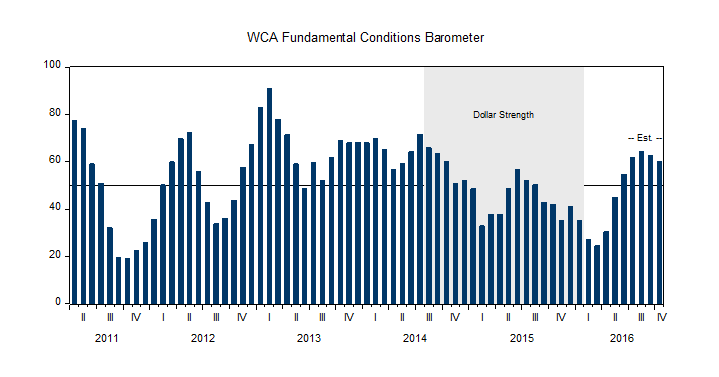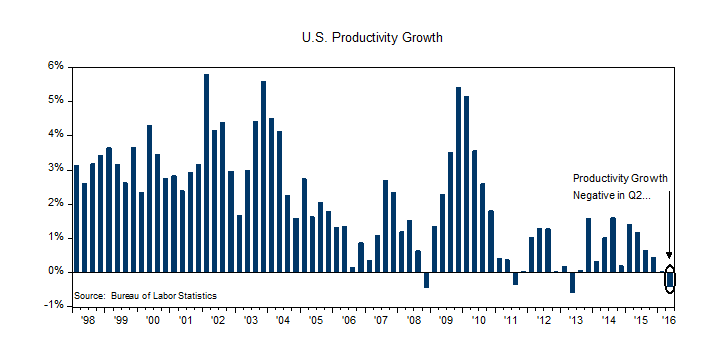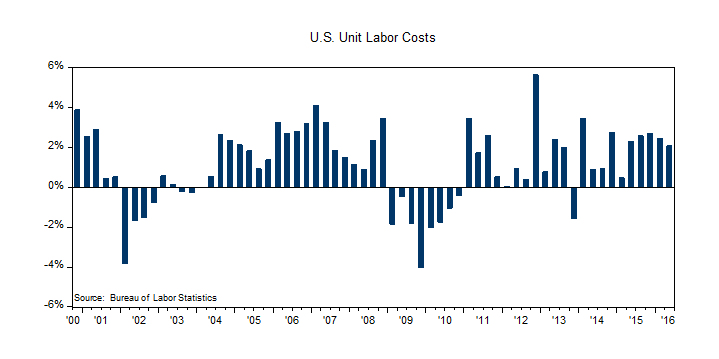Barometer Update
The Federal Reserve (Fed) releases the minutes from July Federal Open Market Committee (FOMC) meeting on Wednesday.
MACRO VIEW
Credit spreads are tighter. Commodity prices are firmer. More stocks are participating to the upside. Financial conditions within the banking system are improving. These are some of the “high frequency” items that are on the mend this year. As this happens, equity markets are performing better.
Our own WCA Fundamental Conditions Barometer (below) is telling a similar story. Around the time markets began to price in a less-hawkish Fed earlier in the year, conditions began to firm. Commodities ended their freefall. Survey measures of manufacturing activity started to improve. Earnings forecasts even got a small lift. Growth started to pick up.
We think it is no accident that the improvement also coincided with a softening of the dollar. Starting back in 2014, the U.S. dollar began a 25% climb on a trade-weighted basis. The strong dollar pressured global trade and dampened growth, particularly outside the United States. It was a year ago that China announced a 2% devaluation to ease some of the pressure coming from a strong dollar. Global markets swooned in the weeks that followed.
Job gains continue, and core price measures are creeping higher. There are only modest increases priced in to markets today. If the economy is, indeed, improving rapidly the dollar could easily strengthen again. For now, we are happy to see the economy picking up from its lumbering pace last winter. A 3-4% growth rate in the third quarter would mark a significant and welcome growth improvement.
Before we sign off, we want to mention two less-followed numbers we got last week. According to the government, productivity turned negative in the second quarter, as unit labor costs rose roughly 2%. The lower productivity trend is a drag on growth, and the higher cost of producing a unit of output is a drag on profits. We expect these trends take time to reverse, and the productivity discussion will likely garner more attention. These trends are worth watching.
Editors’ note: There will be no commentary next week.
ECONOMIC RELEASES THIS WEEK
| Date | Report | Period | Survey | Prior |
| Monday, August 15: | Empire State Mfg. Survey | August | 2.0 | 0.55 |
| NAHB Housing Market Index | August | 60 | 59 | |
| Tuesday, August 16: | CPI M/M | July | 0.0% | 0.2% |
| CPI Ex Food & Energy M/M | July | 0.2% | 0.2% | |
| CPI Y/Y | July | 0.9% | 1.0% | |
| CPI EX Food & Energy Y/Y | July | 2.3% | 2.3% | |
| Housing Starts M/M | July | -1.2% | 4.8% | |
| Building Permits M/M | July | 0.6% | 1.5% | |
| Industrial Production M/M | July | 0.2% | 0.6% | |
| Manufacturing Production M/M | July | 0.2% | 0.4% | |
| Capacity Utilization | July | 75.6% | 75.4% | |
| Wednesday, August 17: | FOMC Minutes from July Meeting | |||
| Thursday, August 18: | Weekly Jobless Claims | August 13 | — | 266 K |
| Philadelphia Fed Business Outlook | August | 1.5 | -2.9 | |
| Friday, August 19: | No Economic Data Releases | |||
ASSET ALLOCATION PORTFOLIO POSTURE
LONG-RUN STRATEGIC POSTURE: Our long-run forecasts lead us to overweight large cap domestic growth stocks, high-yield corporate bonds, and gold in the diversified “core” of portfolios. Underweight positions in “core” are long-term U.S. Treasuries, foreign developed equities, and REITs. Meanwhile the equity allocation in the short-term tactical “satellite” portion of portfolios was increased to 40% equity / 60% fixed income from 33% equity / 66% fixed income. Mid-year rebalancing took place at the end of June to reflect updated long-run forecasts.
The information contained herein has been prepared from sources believed to be reliable but is not guaranteed by us and is not a complete summary or statement of all available data, nor is it considered an offer to buy or sell any securities referred to herein. Opinions expressed are subject to change without notice and do not take into account the particular investment objectives, financial situation, or needs of individual investors. There is no guarantee that the figures or opinions forecasted in this report will be realized or achieved. Employees of Stifel, Nicolaus & Company, Incorporated or its affiliates may, at times, release written or oral commentary, technical analysis, or trading strategies that differ from the opinions expressed within. Past performance is no guarantee of future results. Indices are unmanaged, and you cannot invest directly in an index.
Asset allocation and diversification do not ensure a profit and may not protect against loss. There are special considerations associated with international investing, including the risk of currency fluctuations and political and economic events. Investing in emerging markets may involve greater risk and volatility than investing in more developed countries. Due to their narrow focus, sector-based investments typically exhibit greater volatility. Small company stocks are typically more volatile and carry additional risks, since smaller companies generally are not as well established as larger companies. Property values can fall due to environmental, economic, or other reasons, and changes in interest rates can negatively impact the performance of real estate companies. When investing in bonds, it is important to note that as interest rates rise, bond prices will fall. High-yield bonds have greater credit risk than higher quality bonds. The risk of loss in trading commodities and futures can be substantial. You should therefore carefully consider whether such trading is suitable for you in light of your financial condition. The high degree of leverage that is often obtainable in commodity trading can work against you as well as for you. The use of leverage can lead to large losses as well as gains.
The WCA Fundamental Conditions Barometer measures the breadth of changes to a wide variety of fundamental data. The barometer measures the proportion of indicators under review that are moving up or down together. A barometer reading above 50 generally indicates a more bullish environment for the economy and equities, and a lower reading implies the opposite. Quantifying changes this way helps us incorporate new facts into our near-term outlook in an objective and unbiased way. More information on the barometer is found in our latest quarterly report, available at www.washingtoncrossingadvisors.com/insights.html.
Client-approved reports and commentaries click here
Kevin Caron, Portfolio Manager
Chad Morganlander, Portfolio Manager
Matthew Battipaglia, Analyst
Suzanne Ashley, Junior Analyst
(973) 549-4052






